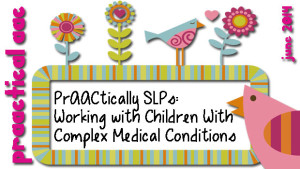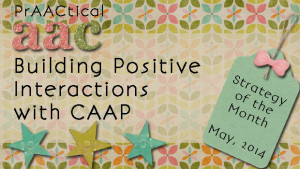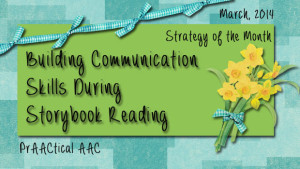July 15, 2019
by Carole Zangari -

We’ve been exploring a bunch of different AAC-related resources on the web. Take a peek. The Regulator: Visual support for Regulation from Amy Laurent. Learn more about it here. Selecting Skills to Teach Communication Partners by Drs. Cathy Binger and Jennifer Kent-Walsh Guidelines for Creating a Communication Board by Vicki Haddix Drafting CVI Progress Charts for Emergent Readers by Deanna Wagner Core Vocabulary and Descriptive Teaching in AAC by the Independent Living Centre of Western Australia
Filed under: Featured Posts, PrAACtical Thinking
Tagged With: Amy Laurent, Cathy Binger, CVI, Deanna Wagner, descriptive teaching, Jennifer Kent-Walsh, Vicki Haddix, visual supports
June 19, 2014
by Carole Zangari -

We are pleased to be sharing another post by a graduate student SLP. Stephanie Amundsen attends the SLP program at the University of Central Florida (UCF) and has worked for the Florida Alliance for Assistive Services and Technology (FAAST) Atlantic Regional Demonstration Center (ARDC) since May 2012. She is currently completing an externship working with children with complex communication needs, and is writing her thesis on AAC access in acute and sub-acute facilities. She has presented posters on service learning using AAC intervention and grammatical intervention using AAC under the direction of Dr. Kent-Walsh at the 2013 ASHA Convention, and has volunteered at the Assistive Technology Industry Association (ATIA) Conference in 2013 and 2014. :::::::::::::::::::::::::::::::::::::::::::::::::::::: As a graduate student placed in my first externship, I encountered multiple clients with AAC needs from day one. Because one of my placement sites is a Prescribed Pediatric Extended Care (PPEC) facility, many... [Read More...]
Filed under: PrAACtical Thinking
Tagged With: FAAST, Jennifer Kent-Walsh, Stephanie Amundsen, UCF, University of Central Florida SLP
May 19, 2014
by Carole Zangari -

One of the challenges in helping AAC learners maximize their communicative potential is that they often interact with people who do not facilitate positive interactions. We know, for example, that partners may focus on the SGD rather than the topic or communicator (e.g., “Can you find ‘go?’, “Press it again”). They may dominate the conversation by taking more than their fair share of turns, making for a lop-sided and uninteresting context that is more of a monologue than a true conversation. They also tend to interrupt the AAC learner, often in an attempt to guess the learner’s message, save time, or correct the person. These actions come from a good place (wanting to support the learner) but are not things that facilitate improved communication. In a previous post, we talked about the RAAP strategy, for building partner skills during storybook reading. In this post, we continue to share the work of... [Read More...]
Filed under: Strategy of the Month
Tagged With: CAAP, Cathy Binger, Jennifer Kent-Walsh, strategy
March 17, 2014
by Carole Zangari -

In this post, we continue to explore strategies for advancing the literacy experiences of people who use AAC. Today, we’ll look at a strategy used in the research of Drs. Cathy Binger and Jennifer Kent-Walsh. What is a little different about this strategy is that it uses literacy experiences, specifically storybook reading, to build communication skills. One component of their research focuses on an interactive reading strategy called RAAP: Read, Ask, Answer, Prompt. There is lots to love about this approach, but one of our favorite things is that is makes heavy use of aided language input, an intervention strategy that is critical for partners of beginning communicators to use. You can read more about aided language input and see videos here. It also gets partners using language expansions and extensions, an intervention strategy that is effective for communicators at many levels of proficiency. Finally, we appreciate the frequent use of... [Read More...]
Filed under: PrAACtical Thinking
Tagged With: aided language input, Cathy Binger, expansion, extensions, Jennifer Kent-Walsh, literacy, pause, RAA, RAAP, reading



